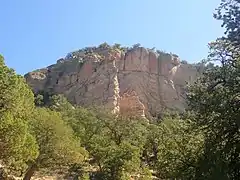Spears Group
The Spears Group is a group of geologic formations exposed in and around the northeast Mogollon-Datil volcanic field of southwestern New Mexico.[2][3] It has a radiometric age of 33 to 39 million years, corresponding to the Eocene to Oligocene epochs.
| Spears Group | |
|---|---|
| Stratigraphic range: Eocene to Oligocene | |
 Dog Springs Formation in the Sawtooth Mountains of New Mexico | |
| Type | Group |
| Sub-units | See text |
| Underlies | Fence Lake Formation Hayner Ranch Formation[1] |
| Overlies | Baca Formation |
| Thickness | 3,000 ft (910 m) |
| Lithology | |
| Primary | Volcaniclastics |
| Other | Andesite |
| Location | |
| Coordinates | 34.281°N 107.296°W |
| Region | |
| Country | |
| Type section | |
| Named by | Tonking |
| Year defined | 1957 |
 Spears Group (the United States)  Spears Group (New Mexico) | |
Description
The group is composed primarily of volcaniclastic beds, deposited in alluvial fans or braided streams, with minor basaltic andesite to dacite lava flows.[3] It contains some lacustrine delta deposits at its base.[4] The total thickness is as much as 3,000 feet (910 m).[3] The group grades below into the Baca Formation[4] and interfingers with lava flows and ash flow sheets of the Mogollon Group and Datil Group.[3]
K-Ar and fission track dating suggest an age of 33 to 39 million years.[3]
The Dog Springs Formation shows striking sedimentary structure indicating that the debris flow beds making up most of the formation slumped over distance scales of miles on the underlying Baca Formation beds. In some locations, clastic dikes derived from the Baca Formation penetrate the overlying Dog Springs Formation.[5]
Formations
The group is divided into numerous formations. In descending stratigraphic order, these are:[6]
- South Crosby Peak Formation
- Rincon Windmill Formation
- Chavez Canyon Formation
- Dog Springs Formation
- Rubio Peak Formation
- Palm Park Formation
- Pueblo Creek Formation
- Bell Top Formation
- Rock Springs Formation
In addition, a number of informal units have been described within the group.
History of investigation
The name was first used by W.H. Tonking in 1957 for the lowest beds of the Datil Volcanics (as then designated).[2] G.R. Osburn and C.E. Chapin raised the unit to formation rank within the Datil Group and divided into members separated by ash flow sheets.[3] In 1994, Steven M. Cather and coinvestigators raised the Spears Formation to group rank and its members to formation rank, redefining the group as all volcaniclastic apron sediments of the Mogollon-Datil volcanic field. They also described several informal formations within the group.[6]
References
- Seager, W.R.; Hawley, J.W.; Clemons, R.E. (1971). "Geology of San Diego Mountain area, Dona Ana County, New Mexico" (PDF). New Mexico Bureau of Mines and Mineral Resources Bulletin. 97. Retrieved 14 August 2020.
- Tonking, W.H. (1957). "Geologic map and sections of the Puertecito quadrangle, New Mexico". New Mexico Bureau of Mines and Mineral Resources Bulletin. 41. Retrieved 24 August 2020.
- Osburn, G.R.; Chapin, C.E. (1983). "Nomenclature for Cenozoic rocks of northeast Mogollon-Datil volcanic field, New Mexico" (PDF). New Mexico Bureau of Mines and Mineral Resources Stratigraphic Chart. 1. Retrieved 25 August 2020.
- Cather, Steven M. (February 1982). "Lacustrine sediments of Baca Formation (Eocene), western Socorro County, New Mexico" (PDF). New Mexico Geology. 4 (1). Retrieved 24 August 2020.
- Osburn, G.R. (November 1985). "Dog Springs Member of the Spears Formation" (PDF). New Mexico Geology. Retrieved 25 August 2020.
- Cather, Steven M.; Chamberlin, R.M.; Ratte, J.C. (1994). "Tertiary stratigraphy and nomenclature for western New Mexico and eastern Arizona" (PDF). New Mexico Geological Society Field Conference Series. 45: 259–266. Retrieved 25 August 2020.